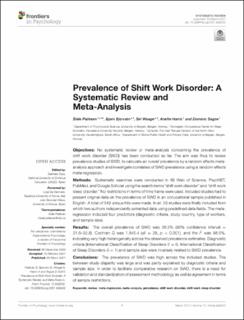| dc.contributor.author | Pallesen, Ståle | |
| dc.contributor.author | Bjorvatn, Bjørn | |
| dc.contributor.author | Waage, Siri | |
| dc.contributor.author | Harris, Anette Kristoffersen | |
| dc.contributor.author | Sagoe, Dominic | |
| dc.date.accessioned | 2021-08-10T13:03:14Z | |
| dc.date.available | 2021-08-10T13:03:14Z | |
| dc.date.created | 2021-05-01T05:16:45Z | |
| dc.date.issued | 2021 | |
| dc.identifier.issn | 1664-1078 | |
| dc.identifier.uri | https://hdl.handle.net/11250/2767214 | |
| dc.description.abstract | Objectives: No systematic review or meta-analysis concerning the prevalence of shift work disorder (SWD) has been conducted so far. The aim was thus to review prevalence studies of SWD, to calculate an overall prevalence by a random effects meta-analysis approach and investigate correlates of SWD prevalence using a random-effects meta-regression.
Methods: Systematic searches were conducted in ISI Web of Science, PsycNET, PubMed, and Google Scholar using the search terms “shift work disorder” and “shift work sleep disorder.” No restrictions in terms of time frame were used. Included studies had to present original data on the prevalence of SWD in an occupational sample published in English. A total of 349 unique hits were made. In all, 29 studies were finally included from which two authors independently extracted data using predefined data fields. The meta-regression included four predictors (diagnostic criteria, study country, type of workers, and sample size).
Results: The overall prevalence of SWD was 26.5% (95% confidence interval = 21.0–32.8). Cochran Q was 1,845.4 (df = 28, p < 0.001), and the I2 was 98.5%, indicating very high heterogeneity across the observed prevalence estimates. Diagnostic criteria (International Classification of Sleep Disorders-2 = 0, International Classification of Sleep Disorders-3 = 1) and sample size were inversely related to SWD prevalence.
Conclusions: The prevalence of SWD was high across the included studies. The between-study disparity was large and was partly explained by diagnostic criteria and sample size. In order to facilitate comparative research on SWD, there is a need for validation and standardization of assessment methodology as well as agreement in terms of sample restrictions. | en_US |
| dc.language.iso | eng | en_US |
| dc.publisher | Frontiers | en_US |
| dc.rights | Navngivelse 4.0 Internasjonal | * |
| dc.rights.uri | http://creativecommons.org/licenses/by/4.0/deed.no | * |
| dc.title | Prevalence of shift work disorder: A systematic review and meta-analysis | en_US |
| dc.type | Journal article | en_US |
| dc.type | Peer reviewed | en_US |
| dc.description.version | publishedVersion | en_US |
| dc.rights.holder | Copyright 2021 The Authors | en_US |
| dc.source.articlenumber | 638252 | en_US |
| cristin.ispublished | true | |
| cristin.fulltext | original | |
| cristin.qualitycode | 2 | |
| dc.identifier.doi | 10.3389/fpsyg.2021.638252 | |
| dc.identifier.cristin | 1907555 | |
| dc.source.journal | Frontiers in Psychology | en_US |
| dc.identifier.citation | Frontiers in Psychology. 2021, 12, 638252 | en_US |
| dc.source.volume | 12 | en_US |

